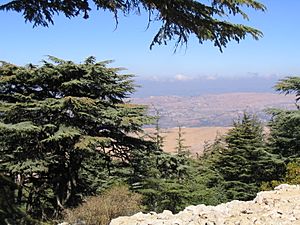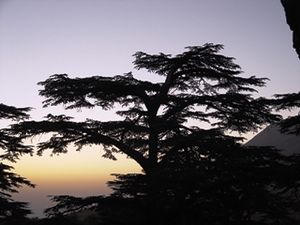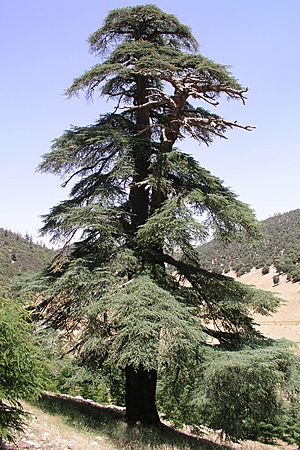Cedar facts for kids
Quick facts for kids Cedar |
|
|---|---|
 |
|
| Lebanon cedar in Al Shouf Cedar Nature Reserve, Barouk, Lebanon | |
| Scientific classification |
Cedrus, common English name cedar, is a genus of coniferous trees in the plant family Pinaceae (subfamily Abietoideae). They are native to the mountains of the western Himalayas and the Mediterranean region, occurring at altitudes of 1,500–3,200 m in the Himalayas and 1,000–2,200 m in the Mediterranean.
Contents
Description
Cedrus trees can grow up to 30–40 m (occasionally 60 m) tall with spicy-resinous scented wood, thick ridged or square-cracked bark, and broad, level branches. The shoots are dimorphic, with long shoots, which form the framework of the branches, and short shoots, which carry most of the leaves. The leaves are evergreen and needle-like, 8–60 mm long, arranged in an open spiral phyllotaxis on long shoots, and in dense spiral clusters of 15–45 together on short shoots; they vary from bright grass-green to dark green to strongly glaucous pale blue-green, depending on the thickness of the white wax layer which protects the leaves from desiccation. The seed cones are barrel-shaped, 6–12 cm long and 3–8 cm broad, green maturing grey-brown, and, as in Abies, disintegrate at maturity to release the winged seeds. The seeds are 10–15 mm long, with a 20–30 mm wing; as in Abies, the seeds have two or three resin blisters, containing an unpleasant-tasting resin, thought to be a defence against squirrel predation. Cone maturation takes one year, with pollination in autumn and the seeds maturing the same time a year later. The pollen cones are slender ovoid, 3–8 cm long, produced in late summer, and shedding pollen in autumn.
Taxonomy
Cedars share a very similar cone structure with the firs (Abies) and were traditionally thought to be most closely related to them, but molecular evidence supports a basal position in the family.
Taxa
The five taxa of Cedrus are assigned according to taxonomic opinion to between one and four species:
| Image | Name | Common name | Synonyms | Distribution | Description | Varieties |
|---|---|---|---|---|---|---|
 |
Cedrus atlantica | Atlas cedar | C. libani subsp. atlantica | Atlas Mountains in Morocco and Algeria | Foliage is dark green to glaucous bluish green, 10–25 mm. | |
 |
Cedrus brevifolia | Cyprus cedar or Cyprian cedar | C. libani subsp. brevifolia, C. libani var. brevifolia | Troodos Mountains in Cyprus | Foliage is glaucous bluish green, 8–20 mm. | |
 |
Cedrus deodara | Deodar, deodar cedar, or Himalayan cedar | – | Native to Western Himalaya | Foliage is brightly green to palely glaucous green, 25–60 mm; cones have slightly ridged scales. | |
 |
Cedrus libani | Lebanon cedar, cedar of Lebanon, or Lebanese cedar | – | Native to Mediterranean mountains in the Near East, Lebanon, and Turkey | The cones have smooth scales. |
|
Ecology
Cedars are adapted to mountainous climates; in the Mediterranean, they receive winter precipitation, mainly as snow, and summer drought, while in the western Himalaya, they receive primarily summer monsoon rainfall and occasional winter snowfall . While some naturalized Cedrus species grow in the Americas, none are native.
Cedars are used as food plants by the larvae of some Lepidoptera species including pine processionary and turnip moth (recorded on deodar cedar).
Use

Cedars are very popular ornamental trees, and are often cultivated in temperate climates where winter temperatures do not fall below circa −25 °C. The Turkish cedar is slightly hardier, to −30 °C or just below. Extensive mortality of planted specimens can occur in severe winters when temperatures fall lower. Locales with successful longaeval cultivation include the Mediterranean region, western Europe north to the British Isles, southern Australia and New Zealand, and southern and western North America.
Cedar wood and cedarwood oil are natural repellents to moths, hence cedar is a popular lining for cedar chests and closets in which woolens are stored. This specific use of cedar is mentioned in The Iliad, Book 24, referring to the cedar-roofed or lined storage chamber where Priam went to fetch treasures to be used as ransom. The ancients made cedarwood oil from Lebanon cedar, a true cedar of the genus Cedrus, However, the species used for modern cedar chests and closets in North America is Juniperus virginiana, and cedarwood oil is now typically derived from various junipers and cypresses (of the family Cupressaceae). Cedar is also commonly used to make shoe trees because it can absorb moisture and deodorize.
Many species of cedar are suitable for training as bonsai. They work well for many styles, including formal and informal upright, slanting, and cascading.
Other pages





